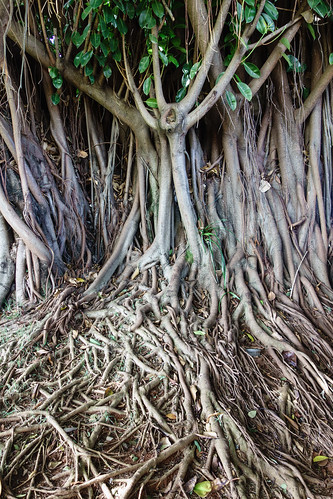I’m reading Richard Powers’s magnificent novel The Overstory at the moment, so I’m learning and appreciating a lot about trees that I hadn’t before. And I’m wishing that I’d know those things before encountering the magnificent specimens in this Sunday’s offering. First, a tree with magnificent roots and multiple trunks (probably from the fig family) that I saw in the grounds of the Brasilia Palace Hotel outside Brasilia in 2013. Second, the wonderful redwoods in Muir Woods in northern California.


{ 12 comments }
Eszter Hargittai 04.26.20 at 3:37 pm
I love trees! These are beautiful examples. I’ve been meaning to read that book for such a long time, thanks for the nudge.
Ingrid 04.26.20 at 6:06 pm
Although I did see some amazing trees in Cameroon last year, I still remember the unique awe I felt when seeing the Redwoods in 2002. We spent a day and night in park, in a tiny little tent, under the trees. I hope I’ll be able to experience this another time in my life; those trees are simply amazing. Your picture might be only a weak substitute for experiencing the real thing, but they do bring back some nice memories :)
Alan White 04.26.20 at 7:35 pm
I’m fortunate to have spent part of my childhood in Northern California and I agree with Ingrid about the redwoods, which in person are almost other-worldly. Fantastic photos.
Dr. Hilarius 04.26.20 at 9:02 pm
The fig tree is wonderful, something not seen in temperate regions. Although I have lots of forest shots not many of singular trees. Here’s a crown of old acacia trees on Maui’s south shore. https://www.flickr.com/photos/143137002@N06/29713305492/in/dateposted-public/
JRLRC 04.27.20 at 1:59 am
Beautiful photos, Chris.
I love trees. A love I owe to my grandfather. They really impress me and remind me of him.
Let me share some of that love with you: https://www.flickr.com/photos/138328836@N06/albums/72157671447020785
John Quiggin 04.27.20 at 3:07 am
Muir Woods is beautiful. But it was sadly dry when we visited last year after long drought. For figs, you can’t beat North Queensland, though my photographic efforts never do it justice. Here are some images https://duckduckgo.com/?t=ffsb&q=cathedral+fig+tree&iax=images&ia=images
bad Jim 04.27.20 at 5:48 am
Of course we all know about the Wood Wide Web
“Trees, from the mighty redwoods to slender dogwoods, would be nothing without their microbial sidekicks. Millions of species of fungi and bacteria swap nutrients between soil and the roots of trees, forming a vast, interconnected web of organisms throughout the woods.”
Eszter Hargittai 04.27.20 at 12:12 pm
Like John, that first picture reminded me of Queensland. I was supposed to be there for a conference in a few weeks. I hope I get to go again before too long.
oldster 04.27.20 at 1:45 pm
bad Jim @7 —
the rhizosphere microbiome has a lot in common with the gut flora microbiome of large mammals. We couldn’t digest much of our food were it not for the wee beasties pre-digesting inside of us, and so too the sequoias would not stay up without micro-beasties passing along nutrients to them.
I wonder in which discipline — botany or human medicine — the centrality of the intermediate digesters was first recognized? Both seem to me to be discoveries of the last few decades, and thus nearly simultaneous in the big picture of human knowledge.
Alternatively, it may be that both of them learned it from the veterinary medical specialists who attend to the guts of ruminants. Decades before I had heard that our guts were full of bugs, I already had heard that cow-guts were full of bugs, helping to break down the cellulose in their fodder.
bad Jim 04.28.20 at 8:46 am
Oldster, I am so weak that I easily succumb to your blandishments. A warning: I am an electrical engineer, lacking any credentialed expertise in the subject on which I am about to expound. I try to keep up, though, so…
the only bacteria we know well are the ones we can culture, which is to say these can grow by themselves on the media we know, like agar. It would appear that such may be in the minority; many bacteria seem to depend on chemicals exuded by other bacteria, making them obligate symbiotes. Biofilms are a phenomenon imperfectly understood; in some environments, like hospital plumbing, they are major hazards, but they may also be key to the health of our gut microbiome.
I say that because no one has so far been able to identify an assortment of bacteria to recolonize an intestine essentially sterilized by antibiotics and opportunistically invaded by C. difficile, for which the most effective therapy remains the transplant of a healthy donor’s entire ecosystem, which is not especially difficult but a process I’d rather not describe.
My point is that our understanding of life on us and life in us looks more like the beginning than the end of the exploration.
Barry 04.29.20 at 12:54 am
That first photo should be titled ‘Intricacy’.
Cola Vaughan 04.30.20 at 10:49 pm
Here’s my attempt to cross-polinate this thread. It’s not the Hoel Chestnut but right now it’s still pretty exciting.
https://www.nytimes.com/2020/04/30/magazine/american-chestnut.html?action=click&module=Top%20Stories&pgtype=Homepage
Comments on this entry are closed.